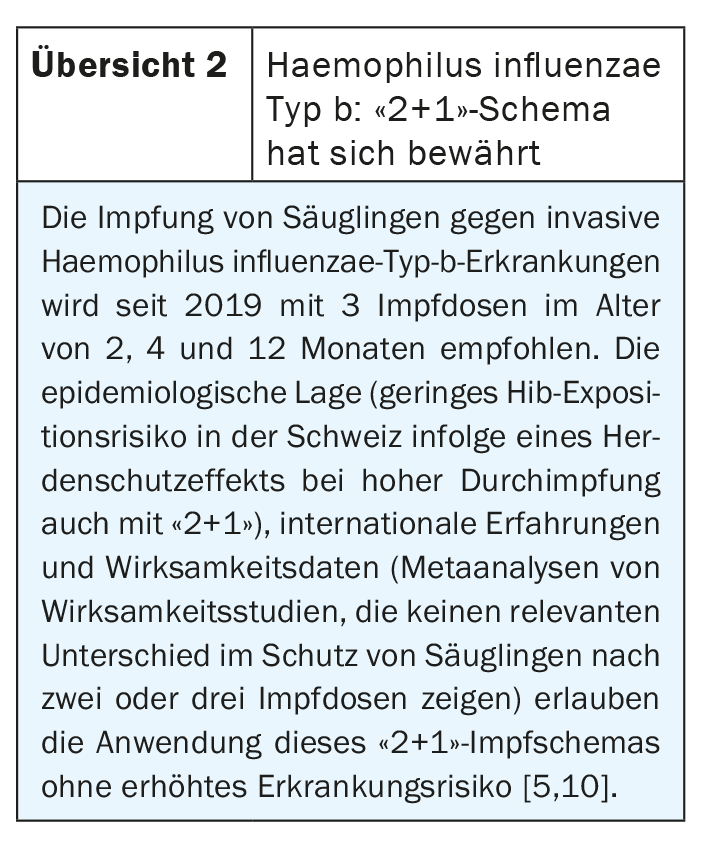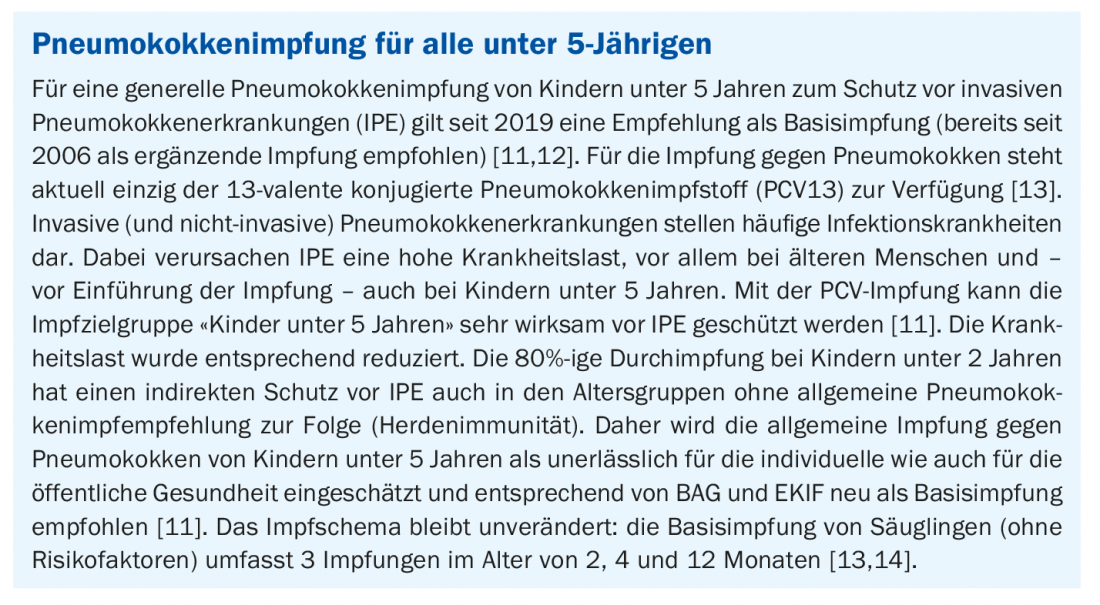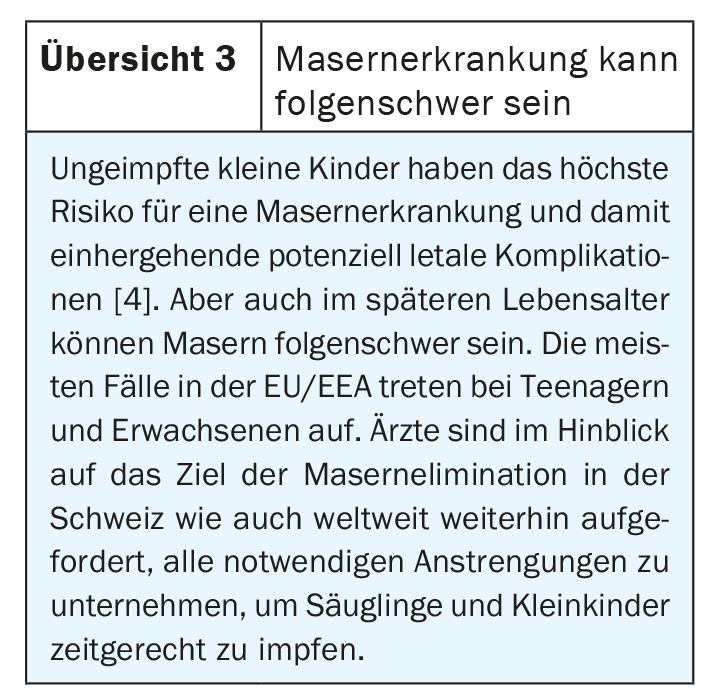Recently, the Swiss Vaccination Plan 2021 was published. It is extremely important to continue to receive all recommended vaccinations during the COVID-19 pandemic. If basic immunizations are neglected, there is a risk of an increase in the number of cases of measles or other vaccine-preventable diseases in a few years.
Guidance on coronavirus vaccination is not part of the 2021 vaccination schedule but is available separately on the FOPH website [1–3]. In 2019, the Federal Commission for Immunization Issues (EKIF) and the Federal Office of Public Health (FOPH) had reassessed the Swiss Immunization Schedule for children up to 2 years of age. The Swiss Vaccination Plan 2021 provides basic vaccinations for children and adolescents against diphtheria, tetanus, pertussis, poliomyelitis (overview 1), invasive Haemophilus influenzae type b infections ( overview 2 ), pneumococci ( box ), measles (overview 3), mumps , rubella, varicella, hepatitis B, and human papillomavirus (HPV). Basic immunizations are essential for individual and public health; supplemental immunizations focus on individual health.


Diphtheria and tetanus: “2+1” scheme
Infant vaccination against diphtheria and tetanus has been recommended since 2019 with an infant vaccination schedule reduced by one dose (“2+1”), which is used in many European countries [5]. In the event of a supply shortage of DTPa vaccines, the use of DTPa-IPV combination vaccines with reduced diphtheria toxoid and pertussis antigen doses, which also elicit a very good immune response in this age group, has also been recommended since 2015 for booster vaccination of children aged 4-7 years who have been fully vaccinated according to the vaccination schedule. This allows greater flexibility in the event of supply bottlenecks. Fully vaccinated specifically means: a total of 4 doses of DTPa-IPV (Hib-HBV) if the 1st dose was vaccinated before 6 months of age according to the previous “3+1” vaccination schedule; a total of 3 doses of DTPa-IPV (Hib-HBV) if the 1st dose was vaccinated from 6 months of age or from 2 months of age with the “2+1” vaccination schedule.

Pertussis: vaccinate infants 2 months and older
Epidemiologic data over the past decade show that severe cases of pertussis continue to be observed in infants younger than 6 months of age, and that increased adolescents and adults represent a significant reservoir of Bordetella pertussis (B. pertussis) [5,8]. Therefore, infants should be vaccinated in time from the age of 2 months. Beginning in 2019, 3 vaccine doses at 2, 4, and 12 months of age are recommended (“2+1” vaccination schedule), instead of the pre-2019 “3+1” vaccination schedule of 4 vaccine doses at 2, 4, 6, and 15-24 months of age [5].
Studies of efficacy in the general population show that a first dose of vaccine protects as many as 50% of infants from severe pertussis. The second dose significantly increases this protection to values between 83% and 87%. The third dose increases vaccine efficacy to 85-95%, depending on the study [5]. Once the booster (“+1”) has been administered, there is no difference in protection between a “2+1” and “3+1” schedule. Thus, the 3rd dose at 6 months of age until booster vaccination at 12 months of age can be omitted because there is already good protection and the risk of complications from pertussis at 6-11 months of age is much lower than in younger infants [5]. The “2+1” vaccination schedule is also recommended for group-supported infants younger than 5 months. However, physicians are free to continue to use an accelerated “3+1” vaccination schedule (at 2-3-4-12 months) depending on individual risk (e.g., entry into a care facility at 3.5 months) (receipt of 2 vaccine doses prior to entry into that facility). This accelerated vaccination schedule, which is also generally recommended for premature infants (<32 0/7 SSW or birth weight <1500 g), may be considered for achieving the earliest possible vaccine protection during an epidemic for all infants.
Measles, mumps and rubella: Do not miss vaccination immunization
The measles, mumps, and rubella (MMR) vaccination schedule has been adjusted [6]: since 2019, the 1st dose is recommended for all infants at 9 months of age and the 2nd dose at 12 months of age. By six months of age, maternal antibody titers in infants of vaccinated women are no longer high enough to provide protection [15,16]. Advancing the 1st MMR dose for all infants from 12 to 9 months of age and eliminating the window for the 2nd dose in favor of 12 months of age should reduce the number of susceptible infants and young children both between 9 and 12 months of age and in the second year of life. The new vaccination regimen also offers high efficacy in the long term [17–19]. For infants with exposure to a measles case, a local outbreak, an epidemic in their area, or travel to an epidemic area, the first MMR dose is recommended as early as 6 months of age. Doses administered before 9 months of age are not counted. Thus, in the case of MMR vaccination at 6 to 8 months of age, a total of three doses are required for complete protection. In this situation, the 2nd dose is given at 9 months of age (minimum 4 weeks after the 1st dose) and the 3rd dose is given at 12 months of age.
Hepatitis B: What are the arguments for vaccination with 3 doses?
Hepatitis B is the most common form of viral hepatitis worldwide. The causative agent is the hepatitis B virus (HBV). It is a DNA virus of the Hepadnaviridae family. Since 2019, basic HBV vaccination has been recommended preferentially for infants using a hexavalent DTPa-IPVHib-HBV vaccine at 2, 4, and 12 months of age [7]. The redefined goal from a public health perspective is that 95% of 16-year-olds should be fully vaccinated against HBV by 2030. The following are the main arguments for general vaccination with 3 doses in infancy [7]:
The World Health Organization (WHO) recommends that 90-95% of infants receive 3 doses of HBV vaccine. Switzerland has not yet achieved this goal either directly in young children (coverage of 53% at age 2) or indirectly in adolescents (70% at age 16) [20].
With 3 doses of combination vaccine in infancy, fewer missed doses and higher coverage, respectively, can be assumed compared with adolescent vaccination. (Current coverage rates for pentavalent vaccines are 96% for 3 doses).
Vaccination in infancy is better at preventing chronic hepatitis B cases because age at infection is inversely proportional to the risk of persistent infection (the risk is highest in newborns, at about 90%). A specific vaccination schedule is still required for infants born to infected mothers.
Seroprotection rates after complete vaccination in infancy are at least as good as those in childhood or adolescence. Changing the focus to vaccinating infants with 3 doses of the hexavalent combination vaccine at 2, 4, and 12 months of age poses no immunologic or epidemiologic risks. Long-term protection is estimated to be as good as with a 4-dose vaccination regimen.
A simpler infant vaccination schedule with 3 doses of combination vaccine instead of the previous 4 simplifies its use in practice.
Literature:
- Swiss Vaccination Plan, www.bag.admin.ch/bag/de/home/gesund-leben/gesundheitsfoerderung-und-praevention/impfungen-prophylaxe/schweizerischer-impfplan.html, (last accessed Apr. 27, 2021).
- Store federal publications for private customers, www.bundespublikationen.admin.ch, (last accessed 04/27/2021).
- Federal Office of Public Health: coronavirus: covid-19 vaccination, www.bag.admin.ch/bag/de/home/krankheiten/ausbrueche-epidemien-pandemien, (last accessed 04/27/2021).
- ECDC: European Centre for Disease Prevention and Control, ecdc.europa.eu, (last accessed 27.04.2021).
- BAG, EKIF: The new “2+1 vaccination schedule” for basic infant vaccination against diphtheria, tetanus, pertussis, poliomyelitis, H. influenzae type b, and hepatitis B: one dose less. Bull BAG 2019; no. 13: 18-22.
- BAG, EKIF. Recommendations for prevention of measles, mumps, and rubella (MMR). Guidelines and Recommendations. Bern: FOPH, 2019.
- BAG, EKIF: Recommendations for the prevention of hepatitis B. Guidelines and recommendations. Bern: FOPH, 2019.
- BAG, EKIF: Recommendations for the prevention of pertussis. Guidelines and Recommendations. Bern: BAG, 2017.
- WHO: Polio vaccines: WHO position paper – March, 2016. Weekly epidemiological record 2016; 12: 14-168.
- WHO. Haemophilus influenzae type b (Hib) Vaccination Position Paper – September 2013. Weekly epidemiological record 2013; 39: 413-428.
- BAG, EKIF: Pneumococcal vaccination of children under 5 years newly recommended as basic vaccination. Bull BAG 2019; no. 13: 32-34.
- BAG, EKIF: Pneumococcal vaccination in children under 5 years of age. Guidelines and Recommendations (formerly Supplementum XVII). Bern: BAG, 2005.
- BAG, EKIF: Recommendations for pneumococcal vaccination in children under 5 years of age: Switch from 7- to 13-valent conjugate vaccine. Bull BAG 2010; no. 51: 1202-1205.
- FOPH: Supplement to Supplement XVII – Fewer vaccine doses, same benefit: Reduction of pneumococcal vaccination schedule in healthy children younger than 2 years. Bull BAG 2006; no. 21: 409-411.
- Leuridan E, et al: Early waning of maternal measles antibodies in era of measles elimination: longitudinal study. BMJ (Clinical research ed.) 2010; 340: c1626.
- Science M, et al: Measles Antibody Levels in Young Infants. Pediatrics 2019; 144 (6).
- Ceyhan M, et al: Immunogenicity and efficacy of one dose meas les-mumps-rubella (MMR) vaccine at twelve months of age as compared to monovalent measles vaccination at nine months followed by MMR revaccination at fifteen months of age. Vaccine 2001; 19: 4473-4478.
- Gans H, et al: Immune responses to measles and mumps vaccination of infants at 6, 9, and 12 months. J Infect Dis 2001; 184: 817-826.
- Klinge J, et al: Comparison of immunogenicity and reactogenicity of a measles, mumps and rubella (MMR) vaccine in German children vac cinated at 9-11, 12-14 or 15-17 months of age. Vaccine 2000; 18: 3134-3140.
- WHO: www.euro.who.int (last accessed 27.04.2021)
HAUSARZT PRAXIS 2021; 16(5): 30-32












